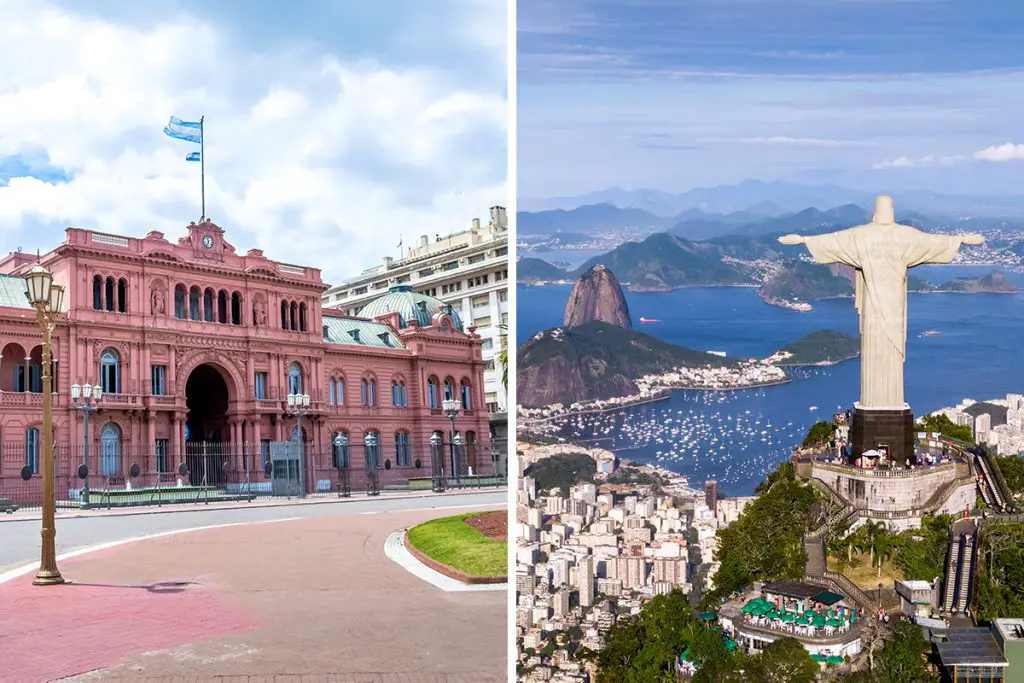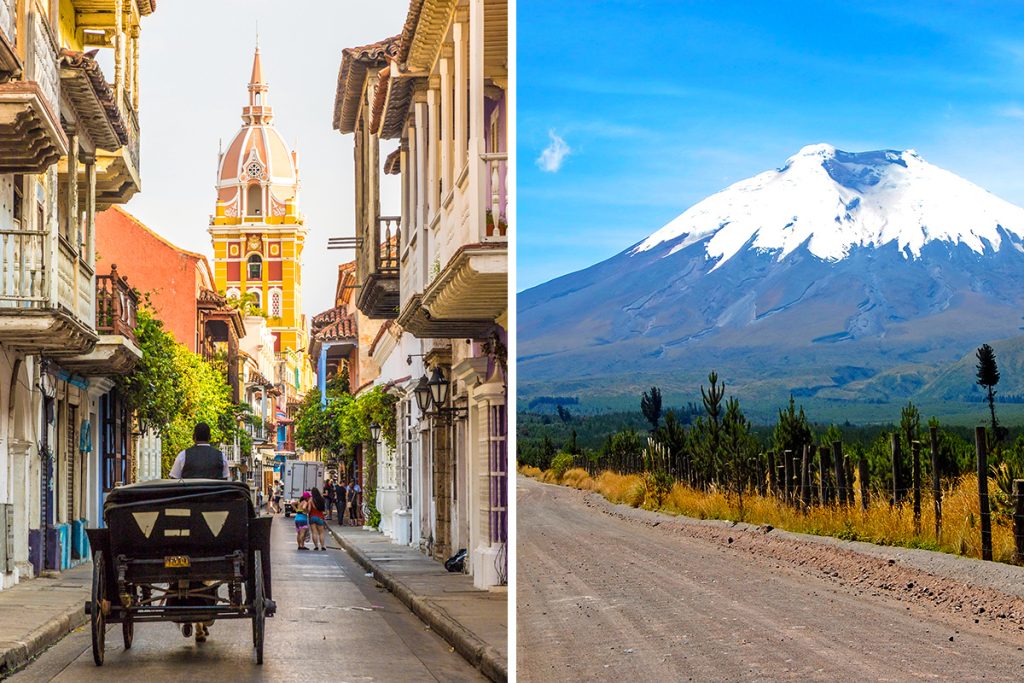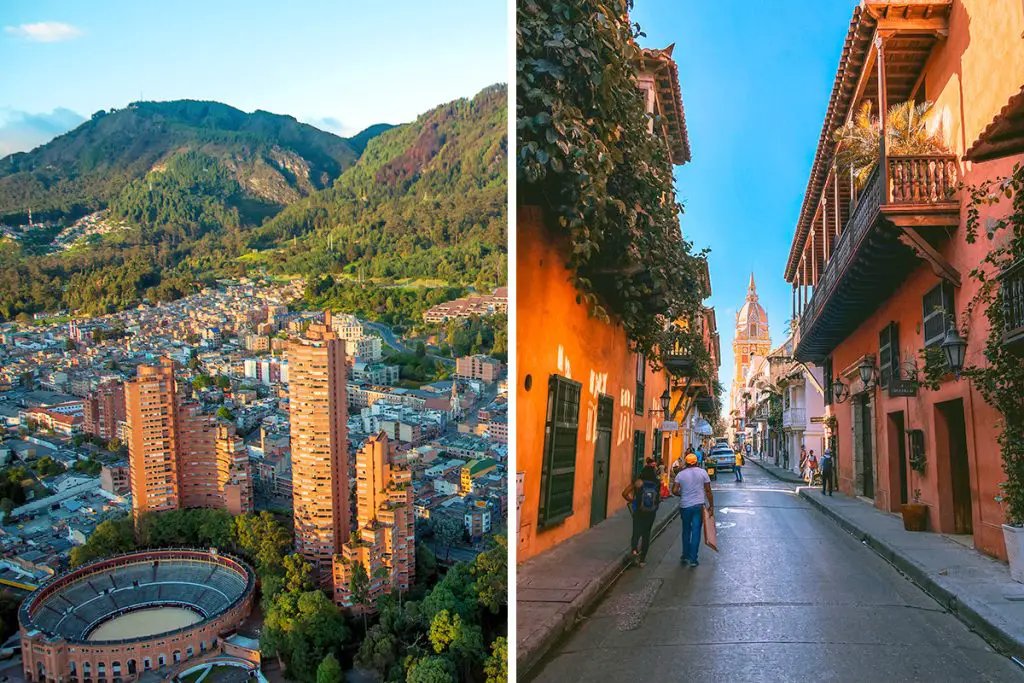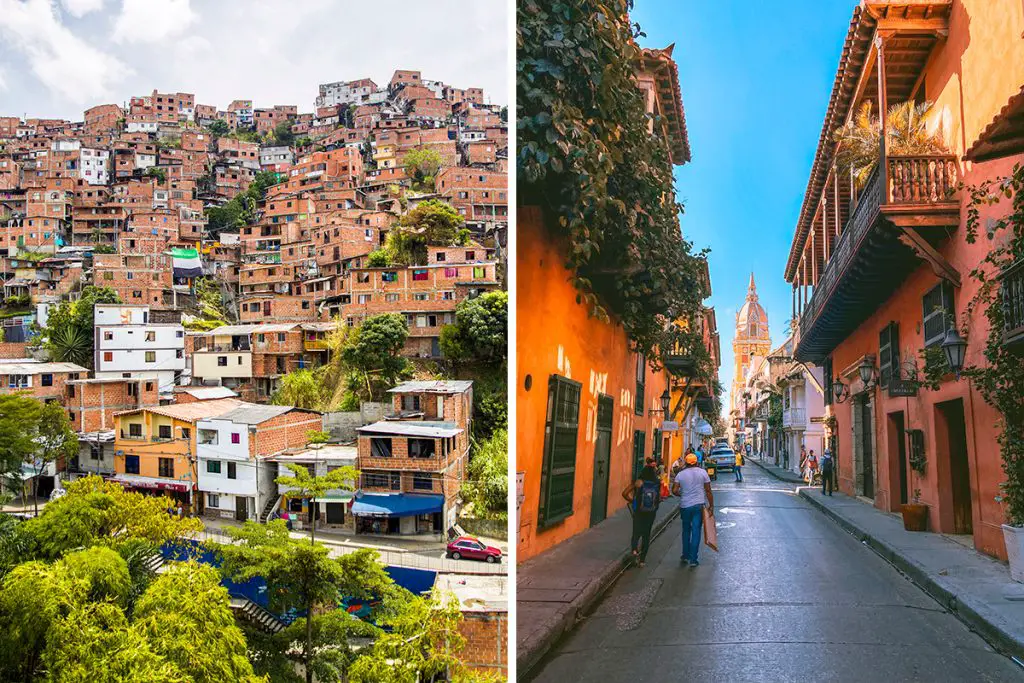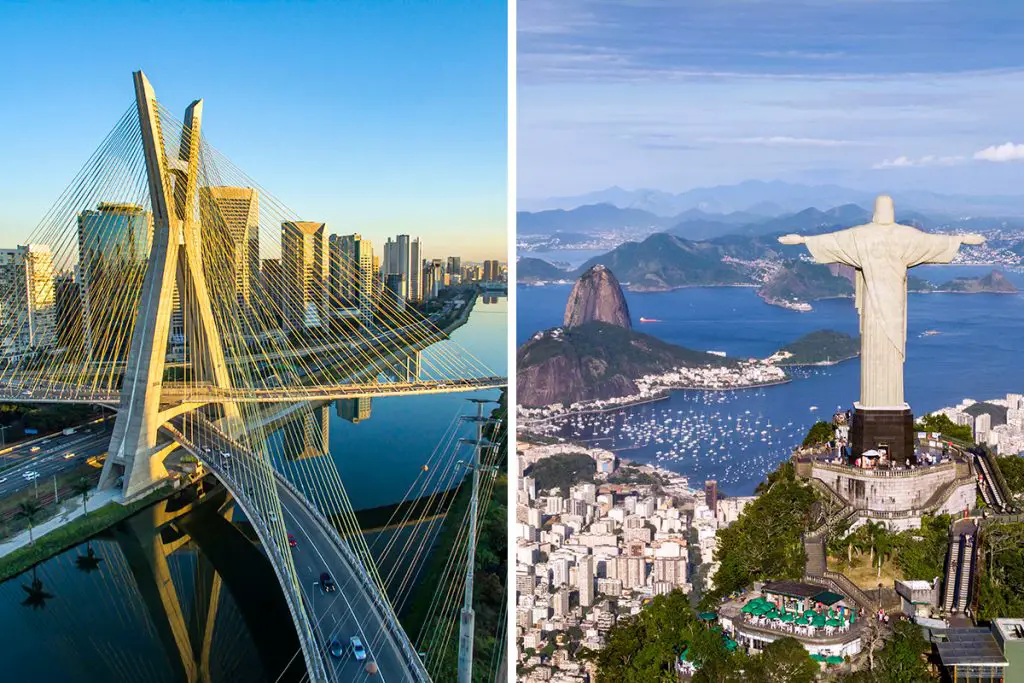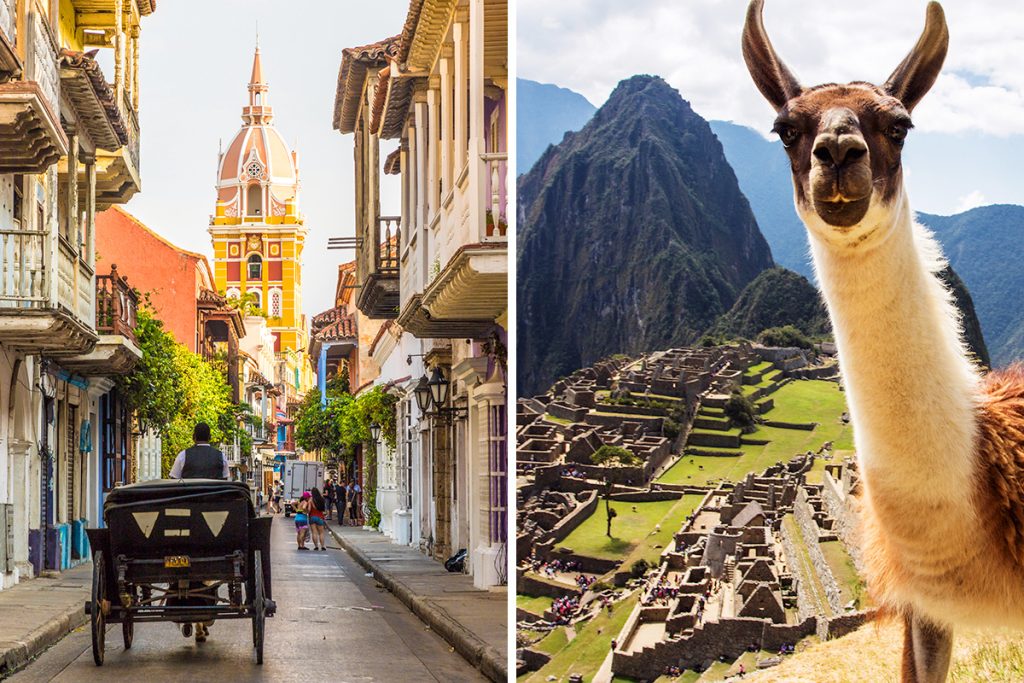Each destination has its own set of advantages, and finding the right fit for your preferences will ensure a memorable trip. In this comparison, we will explore various factors such as history, culture, attractions, activities, and more to help you make an informed decision. So, keep reading to discover the highlights and distinctions of Brazil and Colombia!
History & Culture
Diving into the history and culture of Brazil and Colombia reveals fascinating stories and traditions. Both countries have rich pasts and vibrant cultures that contribute to their appeal as travel destinations.
Brazil’s history is a blend of indigenous, African, and European influences. Its colonial past, marked by Portuguese settlement, is evident in many cities’ architecture. Brazil’s culture is a colorful mix, with samba and Carnival celebrations showcasing its lively spirit.
In contrast, Colombia’s history features a strong indigenous presence, Spanish colonization, and liberation led by Simón Bolívar. Its culture is a fusion of native, African, and European elements, making it diverse and exciting. Traditional music, dance, and festivals vary across regions, reflecting Colombia’s cultural richness.
Attractions related to Brazil’s history and culture are abundant, such as colonial towns, baroque churches, and modern art museums. The country’s passion for soccer is also evident, with stadiums and museums dedicated to the sport.
Colombia’s historical sites include ancient ruins, colonial cities, and impressive museums. Its cultural experiences range from traditional handicrafts to contemporary art galleries, with various regions offering unique insights into Colombia’s heritage.
To summarize, Brazil’s history and culture are marked by its diverse influences and vibrant celebrations, while Colombia’s past is rooted in indigenous traditions and Spanish colonization. Both countries offer countless opportunities to immerse yourself in their unique histories and cultures.
Attractions & Activities
Exploring the attractions and activities in Brazil and Colombia will lead to unforgettable experiences. Each country boasts a variety of exciting things to do that cater to different interests.
Brazil’s attractions include the iconic Christ the Redeemer statue, the Amazon Rainforest, and the stunning Iguazu Falls. Adventure seekers can try activities like hiking, wildlife spotting, and river cruises in the Amazon, while nature enthusiasts will love exploring the Pantanal wetlands.
Colombia’s attractions range from the historic walled city of Cartagena to the ancient ruins of the Lost City. Adventure lovers can trek through the Cocora Valley or go white-water rafting in the Andes, while those interested in wildlife can visit the Amazon region for unique encounters.
Both Brazil and Colombia offer urban experiences, with cities like Rio de Janeiro and Medellín providing a mix of history, culture, and modernity. Visitors can explore street art, museums, and parks, or take in breathtaking views from atop Sugarloaf Mountain or Medellín’s cable cars.
In Brazil, outdoor enthusiasts can enjoy activities like surfing, paragliding, and hang gliding along the coast, while inland, they can experience the thrill of sandboarding on the dunes.
Colombia’s diverse landscape also offers a variety of outdoor adventures, such as horseback riding in the Coffee Region or exploring the Tatacoa Desert’s unique geological formations.
In conclusion, both Brazil and Colombia boast a wide range of attractions and activities that cater to different interests. Whether you prefer urban exploration, outdoor adventures, or cultural experiences, you’re sure to find something captivating in each destination.
Beaches
Beaches are often a top priority when planning a vacation, and both Brazil and Colombia boast stunning coastlines. Each country offers a variety of sandy spots that cater to different tastes and preferences.
Brazil is famous for its picturesque beaches, such as Copacabana and Ipanema in Rio de Janeiro. These urban beaches are popular for sunbathing, swimming, and beach sports. In total, Brazil’s coastline stretches over 4,600 miles (7,400 kilometers), providing countless beach options to explore.
Colombia’s beaches may be lesser-known, but they’re equally beautiful. The Caribbean coast offers gems like Tayrona National Park, where you’ll find pristine, secluded beaches surrounded by lush jungle. Colombia’s coastline spans approximately 2,000 miles (3,200 kilometers), with both Pacific and Caribbean shores to discover.
For surfers, Brazil has excellent options like Florianópolis and Saquarema, known for their consistent waves. Beachgoers who enjoy calmer waters can head to the northeast, where warm, crystal-clear waters are perfect for swimming and snorkeling.
In Colombia, surfers can find great waves on the Pacific coast, while the Caribbean coast offers ideal conditions for snorkeling and scuba diving. The Rosario Islands, located near Cartagena, is a popular spot for underwater exploration.
To sum up, both Brazil and Colombia have amazing beaches that cater to different preferences. Brazil’s coastline is longer and more famous, with iconic urban beaches and surfing spots. Colombia offers pristine, secluded beaches with excellent opportunities for snorkeling and diving.
Eating, Drinking & Nightlife
Savoring local flavors and enjoying nightlife are essential parts of any vacation. Brazil and Colombia both have unique culinary scenes and lively nighttime entertainment to discover.
Brazilian cuisine is diverse, with regional dishes like feijoada and moqueca appealing to various palates. Churrascarias, or Brazilian steakhouses, are also popular, offering a unique dining experience.
Colombian food is equally diverse, with dishes like arepas, bandeja paisa, and ajiaco offering a taste of the country’s varied culinary heritage. The tropical fruit selection in Colombia is also impressive, with exotic options to try.
For drinks, Brazil is famous for its caipirinha, a refreshing cocktail made with cachaça, sugar, and lime. In addition, the country produces some excellent wines, especially in the southern region.
Colombia, on the other hand, is known for its coffee, which is considered among the best in the world. Aguardiente, a local spirit, is also popular and often enjoyed during social gatherings.
Brazil’s nightlife is vibrant and varied, with options like samba clubs, live music venues, and trendy bars catering to different tastes. Rio de Janeiro and São Paulo are particularly well-known for their exciting nighttime entertainment.
Similarly, Colombia’s nightlife offers a mix of salsa clubs, bars, and live music venues. Cities like Bogotá, Medellín, and Cali have thriving nighttime scenes that cater to different interests.
In conclusion, both Brazil and Colombia have diverse culinary scenes, unique local drinks, and exciting nightlife options. Whether you’re a foodie, a partygoer, or just looking to enjoy local flavors, you’ll find plenty to love in each destination.
Shopping
Shopping is a fun way to explore local culture and bring home unique souvenirs. Both Brazil and Colombia offer a range of shopping experiences, from traditional markets to upscale malls.
In Brazil, you’ll find numerous shopping opportunities, including bustling street markets, where you can buy colorful handicrafts, clothing, and local food. São Paulo and Rio de Janeiro are home to luxury malls, featuring both international and local brands.
Colombia also offers a diverse shopping scene, with traditional markets like Paloquemao in Bogotá, where you can find fresh produce and handmade crafts. Major cities such as Bogotá, Medellín, and Cartagena have modern malls with a mix of local and international shops.
Brazil is known for its gemstones, so you might want to purchase jewelry featuring stones like amethyst, topaz, and tourmaline. Havaianas flip-flops, another iconic Brazilian product, make great souvenirs or gifts.
Colombian crafts, like mochilas (handwoven bags) and sombreros vueltiaos (traditional hats), are popular items to bring home. You can also find high-quality leather goods and emeralds, which Colombia is famous for.
In summary, both Brazil and Colombia offer a variety of shopping experiences, from traditional markets to modern malls. Brazil is well-known for its gemstones and Havaianas, while Colombia boasts unique crafts and beautiful emeralds.
Accommodation
Finding the perfect place to stay is an important part of any trip. Both Brazil and Colombia have a wide range of accommodation options to suit different budgets and preferences.
Brazil’s accommodation choices vary from budget-friendly hostels to luxury hotels. Major tourist destinations like Rio de Janeiro, São Paulo, and Florianópolis offer many options, including boutique hotels and charming pousadas (guesthouses).
Colombia also provides various lodging options, including hostels, mid-range hotels, and upscale resorts. Cities like Bogotá, Medellín, and Cartagena have a good mix of accommodations to fit different budgets and styles.
If you’re looking for a more unique experience, Brazil has jungle lodges in the Amazon or eco-resorts in the Pantanal, where you can immerse yourself in nature.
In Colombia, you can find eco-lodges in the Coffee Triangle or boutique hotels in historic neighborhoods like Cartagena’s walled city, providing a distinct cultural experience.
Overall, both Brazil and Colombia offer diverse accommodation options to suit different tastes and budgets. Whether you prefer a budget hostel, a luxury hotel, or a unique eco-lodge, you’ll find the perfect place to stay in either destination.
Family-Friendliness & Children’s Activities
Traveling with family can be a memorable experience, and both Brazil and Colombia have plenty to offer for families and children. Let’s compare the family-friendly activities in each destination.
In Brazil, you’ll find many child-friendly attractions, such as theme parks like Beto Carrero World and Beach Park, both offering thrilling rides and water slides. Rio de Janeiro’s Sugarloaf Mountain and the iconic Christ the Redeemer statue are great for family outings.
Colombia also offers a variety of family activities, like the National Coffee Park, where kids can learn about coffee production while enjoying amusement rides. Medellín’s interactive Explora Park is an exciting science museum that will keep children entertained.
Brazil’s beautiful beaches, like Copacabana and Ipanema, are ideal for families to relax and play in the sun. Additionally, eco-tours in the Amazon or the Pantanal provide a unique opportunity to explore nature together.
In Colombia, you can visit the famous Rosario Islands, where you and your kids can swim with bioluminescent plankton. Hiking through the Cocora Valley or exploring the underground Salt Cathedral of Zipaquirá can also be engaging family adventures.
To summarize, both Brazil and Colombia offer various family-friendly activities and attractions. Brazil is known for its beautiful beaches and theme parks, while Colombia provides unique experiences like the National Coffee Park and the Rosario Islands.
Getting There & Getting Around
Transportation is an essential aspect of any trip. Let’s compare how to get to and travel within Brazil and Colombia.
To reach Brazil, most international flights land in São Paulo or Rio de Janeiro. From the United States, direct flights take about 9-10 hours (4,163 miles / 6,700 km). Colombia’s main international airports are in Bogotá, Medellín, and Cartagena, with direct flights from the US taking around 5-7 hours (2,420 miles / 3,900 km).
Within Brazil, domestic flights are the quickest way to travel between cities, but buses are a more affordable option. For shorter distances, taxis and rideshare services like Uber are available, while larger cities like São Paulo and Rio de Janeiro also have metro systems.
Similarly, in Colombia, domestic flights and buses connect major cities. Taxis and rideshare apps are accessible in urban areas, and some cities like Bogotá and Medellín offer public transportation options such as the TransMilenio and Metro, respectively.
Renting a car is possible in both countries, but driving conditions can be challenging due to traffic and road quality. It’s essential to exercise caution and follow local driving rules.
In summary, reaching and traveling within both Brazil and Colombia is relatively easy, with a variety of transportation options available. Direct flights from the US are longer to Brazil, while Colombia has shorter travel times. Both countries offer domestic flights, buses, and local transportation to help you explore their unique destinations.
Weather
When planning a trip, weather plays a crucial role. Let’s compare the weather in Brazil and Colombia to help you decide the best time to visit each destination.
Brazil is a vast country with varied climates. In general, the coastal regions have a tropical climate with temperatures around 75-85°F (24-29°C). The inland areas can be cooler, with temperatures ranging from 65-75°F (18-24°C). Brazil’s rainy season varies depending on the region, so it’s essential to check the specific location you plan to visit.
In Colombia, the climate is mostly tropical and varies according to altitude. The coastal areas are hot and humid, with temperatures between 75-90°F (24-32°C). The Andean region, including Bogotá, has a cooler climate with temperatures from 50-70°F (10-21°C). Colombia’s rainy season typically occurs from April to May and October to November.
If you’re seeking warm weather, Brazil’s coastal regions or Colombia’s Caribbean coast offer plenty of sunshine. For cooler temperatures, consider Brazil’s inland areas or Colombia’s Andean region.
To sum up, both Brazil and Colombia have diverse climates with varying temperatures and rainfall patterns. You should consider your preferred weather and the specific regions you plan to visit when choosing between these two destinations.
Safety
Safety is an important factor to consider when traveling. Let’s discuss the safety aspects of Brazil and Colombia.
Both Brazil and Colombia face similar concerns, such as petty crime, pickpocketing, and theft, particularly in tourist areas. It’s essential to be cautious and aware of your surroundings, especially in crowded places.
In Brazil, some areas have higher crime rates than others. You should avoid favelas (slums) and exercise caution at night. While most tourist attractions are generally safe, it’s wise to stay vigilant and follow local advice.
Similarly, in Colombia, it’s crucial to remain cautious in urban areas and avoid neighborhoods with high crime rates. Stick to well-traveled areas and avoid walking alone at night.
Natural hazards are another safety concern. Brazil’s Amazon region can present challenges like tropical diseases, while Colombia is located in an earthquake-prone zone.
In conclusion, both Brazil and Colombia have safety concerns related to crime and natural hazards. Staying vigilant and following local advice can help minimize risks and ensure a safe and enjoyable trip.
Cost
When planning a trip, cost is an essential factor. Let’s compare the expenses you might face in Brazil and Colombia to help you make a decision.
In Brazil, the currency is the Brazilian Real (BRL). The cost of living is generally reasonable, with a meal at an inexpensive restaurant costing around 20 BRL ($4). Accommodation varies, but you can find budget hotels starting at 100 BRL ($20) per night.
Colombia uses the Colombian Peso (COP) as its currency. The cost of living is relatively low, with a meal at an affordable restaurant priced at around 15,000 COP ($4). Like Brazil, accommodation prices range, but you can find budget options starting at 50,000 COP ($14) per night.
When it comes to transportation, both countries offer various options. In Brazil, a one-way local transport ticket costs around 4 BRL ($1), while in Colombia, it’s approximately 2,500 COP ($0.70).
For attractions and activities, prices in both countries depend on the type and location. In general, Brazil may have slightly higher prices for popular tourist sites compared to Colombia.
In summary, both Brazil and Colombia are affordable destinations with varying costs for food, accommodation, transportation, and attractions. Colombia might be slightly cheaper overall, but you should consider your preferences and planned activities when deciding between the two countries.
Which Is Better – Brazil or Colombia?
Choosing between Brazil and Colombia can be challenging as both countries offer rich history and culture, beautiful beaches, delicious cuisine, and lively nightlife. This conclusion will help you decide which destination suits your preferences.
If you’re interested in exploring diverse historical and cultural experiences, Brazil’s vast size and rich history might be more appealing. For those looking for unique attractions and activities, Colombia’s diverse landscapes and charming cities offer plenty of options.
Beach lovers might prefer Brazil’s extensive coastline and famous beaches, while those seeking a culinary adventure may find Colombia’s diverse and flavorful cuisine more enticing.
In terms of family-friendliness, both countries offer a variety of children’s activities, but it’s essential to consider safety and accessibility when traveling with kids.
For budget-conscious travelers, Colombia is generally more affordable, but Brazil’s reasonable prices make it an attractive option as well.
Finally, when considering weather, you’ll find a wide range of climates in both countries, so choosing the ideal destination depends on your preferred temperature and rainfall patterns.
In conclusion, the choice between Brazil and Colombia depends on your interests, budget, and preferences. By evaluating the information provided in this article, you can make an informed decision and create a memorable travel experience tailored to your desires.


